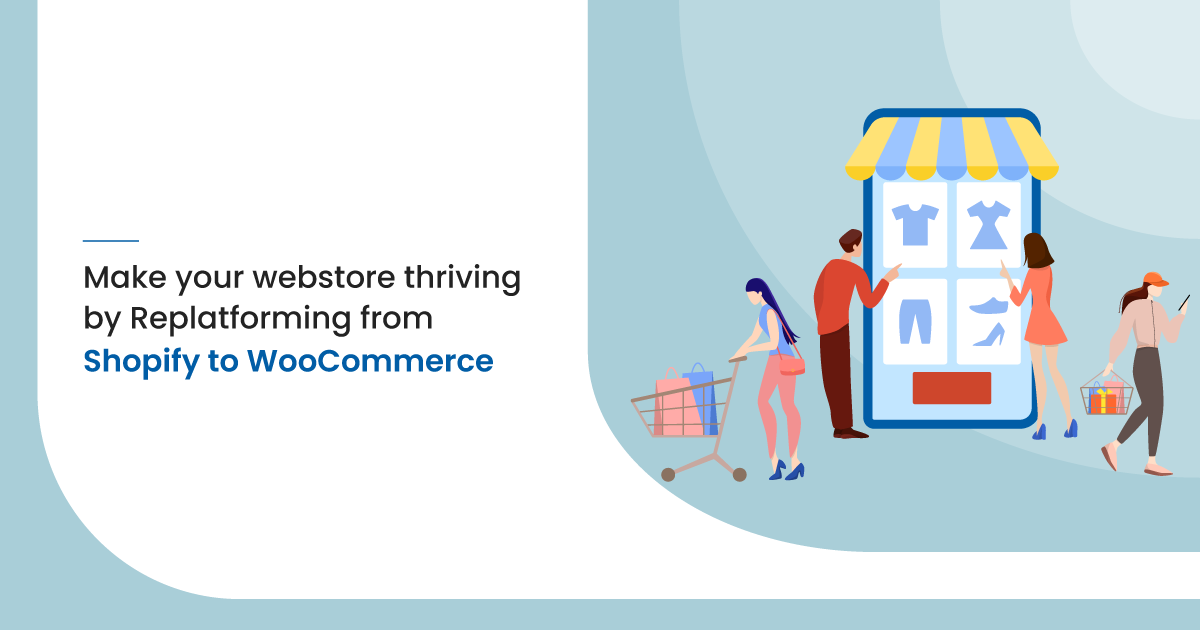In the era of digitalization, the eCommerce industry is truly a gold mine in the eyes of e-merchants and those who are planning to run online businesses. Shopify, WooCommerce, and many other eCommerce platforms come with numerous features that satisfy diverse business demands among countless choices.
If you are new or still confused about choosing a suitable platform, take a look at this insightful report that predicts the winning eCommerce platforms in 2021 by compiling different data sources.
Many people choose Shopify to settle in thanks to its ease of use and dedicated support. However, it is not a one-size-fits-all option for store owners. In this case, many merchants may think of WooCommerce as an ideal alternative. However, here comes another question, what is the most effective way to migrate data from Shopify to WooCommerce? Therefore, in this article, we will compare three methods to perform Shopify to WooCommerce data switch and then recommend several ways to monetize your new WooCommerce store after the migration.
Disadvantages of Shopify
Before diving deeper into the comparison of three migration solutions to migrate from Shopify to WooCommerce, some of you may be curious about how WooCommerce can perfectly replace Shopify. Hence, in this part, we will be clarifying what you need to know about Shopify’s drawbacks. Let’s check it out!
1. Pricing
In spite of the fact that Shopify offers separate plans for e-merchants to choose from, the price of each package is relatively costly (ranging from $29 to $299 per month). Besides that, if store owners use third-party payment processors instead of Shopify Payment itself, they need to pay a transaction fee, as in the image below. The higher plan you select, the lower the additional expense you have to spend.
 Regardless of fixed monthly price and additional expense on every transaction, Shopify users are also suggested to purchase themes and apps. Without doing this way, your products may fail to get more potential customers due to unattractive storefront or ineffective management system.
Regardless of fixed monthly price and additional expense on every transaction, Shopify users are also suggested to purchase themes and apps. Without doing this way, your products may fail to get more potential customers due to unattractive storefront or ineffective management system.
Contrary to Shopify, WooCommerce doesn’t charge any monthly fee since it is a self-hosted solution.
However, you need to buy hosting, domain name, store template, add some plugins and extensions, or hire technical experts to develop your site. Of course, you may not need all the features mentioned above. Especially, a firm technical base is a plus as you can save a lot on developer fees. Apparently, the price to install and operate a WooCommerce store is much lower than that of a Shopify website.
2. SEO friendliness
Similar to the SEO features of other platforms, Shopify allows its users to add title, meta description, and images in an easy, straightforward way. However, Shopify is not an optimal choice for store owners if they want to focus on improving their page ranking.
 The bad news is that you cannot remove some strings from certain URLs. For instance, the URL address of a product page will contain ‘/products/’ by default. In addition, you are not able to make any changes to your Robots.txt file or Sitemap. This is a stumbling block for those who are serious about site optimization.
The bad news is that you cannot remove some strings from certain URLs. For instance, the URL address of a product page will contain ‘/products/’ by default. In addition, you are not able to make any changes to your Robots.txt file or Sitemap. This is a stumbling block for those who are serious about site optimization.
On the other hand, WooCommerce leaves Shopify miles behind when it comes to SEO features. Being a WooCommerce merchant, you can literally edit every single aspect of your SEO with some simple code lines needed.
3. Blogging features
Unfortunately, blogging is not the main focus of Shopify, although it does offer this feature. Therefore, this platform only gives you some basic functionality to write posts. If you expect things like blogging analytics or social bookmarking, Shopify is definitely not for you.
 In contrast, WooCommerce comes with a powerful Content Management System built-in and a dedicated blogging system. Especially, you can integrate your WooCommerce store with WordPress to publish non-commercial content so that your clients can find the information they want to know without leaving the site.
In contrast, WooCommerce comes with a powerful Content Management System built-in and a dedicated blogging system. Especially, you can integrate your WooCommerce store with WordPress to publish non-commercial content so that your clients can find the information they want to know without leaving the site.
4. Customizability
Shopify is famous for being a one-stop-shop that provides everything you need to create an online store quickly and easily. However, this platform limits its users to have full control over their store. The only way you can improve your website presence is to spend a significant amount of money installing add-ons from Shopify Apps Store.
 Unlike the rival, WooCommerce is an open-source platform that allows users to copy and modify the source code as they wish. In other words, there are endless customization options for those who have the technical foundation to create specific store themes or plugins on their own.
Unlike the rival, WooCommerce is an open-source platform that allows users to copy and modify the source code as they wish. In other words, there are endless customization options for those who have the technical foundation to create specific store themes or plugins on their own.
Among all of the factors discussed above, WooCommerce turns out to be an ultimate alternative to Shopify. This self-hosted solution comes as a rescue by providing what Shopify needs to improve. Therefore, don’t hesitate to migrate to a more robust platform if you find your current one fall short of your expectation.
In the next paragraphs, we’ll show you the differences of 3 ways you can take into consideration when migrating from Shopify to WooCommerce. Keep reading on!
Three methods to move from Shopify to WooCommerce
Regarding transferring store entities from Shopify to WooCommerce, you currently have three options to choose from. Take a look at our comparison below to make a proper decision for your re-platforming. But first, don’t forget to create a WooCommerce store and backup data on Shopify to prevent any possible risks.
1. Migrate manually
Manual migration means that you will export data from Shopify and later import this file into your newly-created WooCommerce store. By doing this way, there is no need to worry about data leaking because you are in charge of the whole process. Additionally, it is totally free, which is suitable for those who have a limited budget.
However, you may waste a lot of time and effort comparing the database structure of both platforms. This solution is even more difficult for eCommerce newbies or non-coders because they will face a high chance of unexpected errors arising while migrating from Shopify to WooCommerce.
Please note that Shopify only allows e-merchants to export some types of store information into CSV files. As the same token, you can import several data types to WooCommerce.
2. Hire professionals
Suppose you are not tech-savvy and too busy to migrate on your own; asking for help from a web agency or developer would be a decent choice. They will take care from A to Z and transfer more store entities that you can’t do manually.
The technique that the professionals use is identical to manual migration (exporting and importing the data). The only difference is that they are able to check the platform compatibility better. This is the reason why the fee to hire them is usually expensive (around $50 – $80 per hour).
However, not all web agencies and freelancers can guarantee that they understand 100% data structure of 2 different platforms. Chances are that unexpected errors are occurring when transferring data from Shopify to WooCommerce. Thus, it takes more time to crawl and/or fix the technical issues, leading to a huge bill after the deal. Also, you may face the risk of losing valuable business data because you cannot control the whole migration process. So, think carefully before choosing this method.
3. Use an automated tool
The final solution, also the most optimal choice, is to use an automated shopping cart migration tool to perform Shopify to WooCommerce switch. First, you can perform the full process on your own after trying the free demo to see how it would work. Second, the migration process is cloud-based. Hence, you don’t have to keep the browser or the network connection during the migration process. Last but not least, your store entities can be placed on the new site accurately within a few minutes.
LitExtension is a leading provider of shopping cart migration services. In comparison with manual migration, the LitExtension tool can transfer almost every important data, including products, customers, orders, pages, blog posts, coupons, etc…Especially, their service doesn’t make any changes to your Shopify store. Therefore, your old site can operate normally and receive new customers or orders. At the same time, all the data selected will be transferred flawlessly to your new WooCommerce store at a reasonable expense.
 Besides basic entities, the LitExtension migration tool also provides additional options that expand the migration possibility. For example, you can choose to migrate customer passwords, SEO URLs, Product descriptions, and other custom fields as you wish.
Besides basic entities, the LitExtension migration tool also provides additional options that expand the migration possibility. For example, you can choose to migrate customer passwords, SEO URLs, Product descriptions, and other custom fields as you wish.
Since the dawn of the foundation, LitExtension has successfully migrated 150,000+ stores with 98% customer satisfaction from 50,000+ customers worldwide. Surely, this tool is the best choice for you to take the very first steps to grow your store on a more suitable platform.
Boost sales with WooCommerce after the migration
After choosing the most ultimate migration method to transfer your data from Shopify to WooCommerce, it’s time to invest in the new site and earn more money from a brand-new business.
Before expecting to boost sales and revenue, it is of importance to keep your online store operating in an effective, organized flow. Understanding the needs to improve the business, hundreds of eCommerce service providers appear with powerful tools that come in handy.
You can take advantage of 8 free tools for entrepreneurs suggested by SoftwareSuggest. They are divided into different categories, including Accounting, Invoicing, Human Resource Management, etc.
Besides these toolkits, store owners can enlighten their knowledge about creating long-term plans for their online businesses by reading informative project management blogs. Although this is not an easy task, being a wise project manager will strengthen your business to overcome potential market challenges (e.g., the COVID-19 pandemic).
 After building a steady foundation for your business, the next step is to uplift your product visibility in front of more potential customers. Email marketing has always been one of the most cost-effective ways to raise customer awareness and persuade them to place orders. Take a look at this article and follow 6 steps to generate leads via Email Newsletters.
After building a steady foundation for your business, the next step is to uplift your product visibility in front of more potential customers. Email marketing has always been one of the most cost-effective ways to raise customer awareness and persuade them to place orders. Take a look at this article and follow 6 steps to generate leads via Email Newsletters.
However, it is even more crucial to satisfy customers and keep them returning to your store. In this case, advertising your store via different social media channels would be a decent strategy. You can read this article to see how social media can significantly drive more eCommerce sales for your store.
Conclusion
This article provides the pros and cons of three ways to migrate from Shopify to WooCommerce for your consideration. As a store owner, data security is the top priority. Therefore, if you are confident in your technical skills, you can migrate your store manually because it is the most economical selection. Using automated shopping cart migration tools like LitExtension would be a better method regarding expense and performance.
LitExtension currently supports nearly 100 carts; therefore, you can migrate from Shopify to WooCommerce, Magento to WooCommerce, and the like.
After the migration process, WooCommerce store owners can avail of a reservoir of toolkits that help to facilitate their business. In addition, don’t forget to keep up with the upward technology trend to drive more sales and revenue for your virtual store.
Need Any Technology Assistance? Call Pursho @ 0731-6725516




